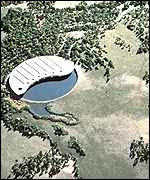
In one of the latest developments, in the treatment of stroke occurring due to clotting of blood in the brain, doctors at UNC Hospitals in Chapel Hill(U.S.A) have been successfully testing the method of exposing brain tissue to high-intensity infrared energy to keep it alive while it's cut off from blood, oxygen and nutrients caused by a blockage from the stroke.
The patients receive high-intensity infrared energy from a device, called NeuroThera, applied to their heads.Infrared energy therapy offers the potential for a new treatment where there are now few options. The only drug approved as a treatment for stroke is tPA, or tissue plasminogen activator. It helps restore blood flow to the brain by breaking up clots, the culprits behind the vast majority of strokes. But it must be given within three hours of the onset of symptoms. At best, about 5 percent of stroke patients are treated.
One advantage that NeuroThera is said to offer is that it can be used to treat patients up to 24 hours after the onset of stroke symptoms. Patients receive multiple bursts of energy-- enough to treat the entire brain. A complete treatment takes about an hour.It is being said that treatment with the device has no known side effects; the only downside being that patients must have their heads shaved to get the treatment as hair absorbs some of the energy intended to treat brain tissue.
 If you grow old in Japan, expect to be served food by a robot, ride a voice-recognition wheelchair or even possibly hire a nurse in a robotic suit — all examples of cutting-edge technology to care for the country's rapidly graying population.
If you grow old in Japan, expect to be served food by a robot, ride a voice-recognition wheelchair or even possibly hire a nurse in a robotic suit — all examples of cutting-edge technology to care for the country's rapidly graying population.















